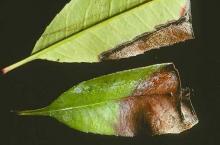Cause Pestalotiopsis sydowiana, a fungus. A minor problem in the field but potentially severe in propagation. Leaf infection usually follows an injury such as sunburn, sunscald, or low temperature. Infection can be severe if leaves, on cuttings in cutting beds, are cut in half to reduce transpiration combined with heavy misting.
Symptoms Plants-the spot is at first white in the middle with a dark-brown margin; later it becomes a blotch. Small fungal fruiting bodies (acervuli) dot the spot's surface.
Cuttings-a brown necrotic area starting at the leaf's cut edge may develop in a circular pattern with fungal fruiting bodies (acervuli) in the center. Later, leaves may yellow and drop off.
Cultural control
- Choose planting site to reduce sunburn, sunscald, or low-temperature injury as much as possible.
- Do not take cuttings from infected plants.
- Use a clean, sharp tool to remove leaf tissue on cuttings. Clean tools and soak in disinfectant. Use two tools so a worker can trim or cut with one while the other soaks. When done with a batch, cultivar, etc. switch one tool for the other and allow the used one to soak.
- Space cuttings for good air circulation.
- Use as little misting as possible after sticking. Use only enough water to prevent cuttings from wilting. Mist should not wet the media until roots are formed. Adjust misting based on weather conditions such as sunny vs. cloudy weather.
Chemical control Fungicide use has been unsuccessful.
Reference White, R.P. 1930. Pathogenicity of Pestalotia spp. on rhododendron. Phytopathology 20:85-91.

